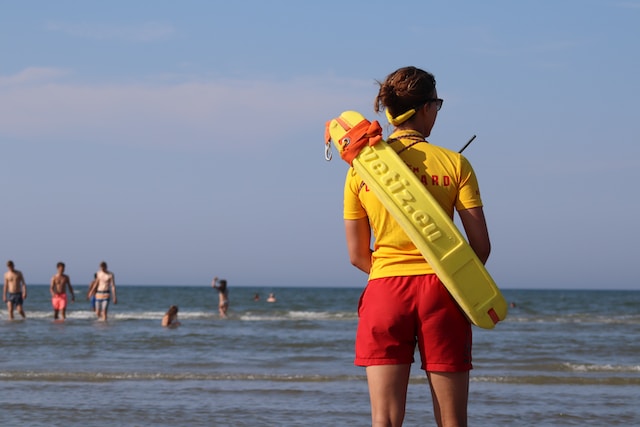- Lifeguarding requires strong swimming skills, physical fitness, and certifications in First Aid, CPR, and lifeguard training from a renowned authority.
- Lifeguard training programs, like those provided by the American Red Cross, equip candidates with necessary surveillance techniques, rescue skills, and first aid protocols.
- Physical fitness training is crucial for lifeguards as the job demands strength, endurance, speed, and agility.
- Communication skills are essential in lifeguarding for effective interaction with others, conveying safety instructions, and working collaboratively with a team.
- Gaining practical experience through volunteering and pursuing advanced lifeguard certification can enhance career prospects in lifeguarding .
If you’re aspiring to become a professional lifeguard, there are key skills and qualifications you need to master. Lifeguarding is more than just a summer job; it’s about vigilant surveillance, quick response to emergencies, and ensuring public safety.
You’ll need to develop strong swimming skills, achieve First Aid and CPR certification, and acquire lifeguard training from a recognized authority. Having a high level of physical fitness and excellent communication skills are also crucial in this role. Dive into the best ways to prepare for this challenging yet rewarding profession.
Take Swimming Lessons

Swimming effectively is the cornerstone of lifeguarding and, as such, your first step should be to enroll in swimming lessons. In these lessons, focus on polishing your strokes, building endurance, and improving your speed. You’ll need to master the common styles such as freestyle, breaststroke, backstroke, and butterfly, as lifeguards should be capable of swimming in various forms depending on the situation.
It’s equally important to become comfortable with treading water and diving. Many lifeguard certification programs require a pre-requisite swimming test, typically involving a timed swim of approximately 300 yards , treading water for two minutes using legs only, and retrieving a 10-pound object from a depth of 7 to 10 feet . Regular practice will help you meet these requirements and ensure you’re equipped for the physical demands of lifeguarding .
Enroll in a Certified Lifeguard Training Program
Once you’ve honed your swimming skills, the next step is to enroll in a certified Lifeguard Training Program. These programs teach you the necessary skills to prevent and respond to aquatic emergencies. They cover various topics, such as surveillance techniques, victim recognition, rescue skills, and first aid protocols. Choosing a nationally recognized program, like those offered by the American Red Cross is crucial.
Typically, these programs include classroom learning and practical sessions, allowing you to gain hands-on experience. The coursework often encompasses understanding the role and duties of lifeguards, injury prevention, decision-making processes, and emergency response systems. Completing such a program certifies your ability and boosts your confidence in handling critical situations effectively. Moreover, there are other things you should consider:
Undergo Physical Fitness Training
Physical fitness is paramount in lifeguarding as it involves high-stress situations that require strength, endurance, speed, and agility. Therefore, regular fitness training should be an integral part of your preparation. This can include cardio exercises like running or cycling to improve your stamina, strength training for muscle building, and flexibility exercises for better movement and agility.
Remember, as a lifeguard, you might be called upon to swim long distances, tread water for extended periods, or even carry or tow individuals to safety. Simulating rescue situations during your training sessions is also beneficial to better prepare for real-life scenarios.
Physical fitness training aims not just to pass the prerequisites for a lifeguard certification program but also to ensure that you’re physically capable of saving lives when duty calls. Regular fitness training will help you to stay fit, enabling you to perform at your best in any situation.
Attend a CPR Refresher Course
CPR (Cardiopulmonary Resuscitation) and AED (Automated External Defibrillator) certifications are necessary for all lifeguards. Regularly attending a CPR refresher course ensures that your skills are up to date and you are ready to perform in real-life situations. These courses typically cover recognizing life-threatening emergencies, providing high-quality chest compressions , delivering appropriate ventilations , and effectively using an AED.
They also include training on how to assist choking victims. Remember the importance of renewing your certification every two years, as CPR guidelines may be updated periodically based on new scientific findings. Being confident in your CPR abilities is crucial to lifeguarding , as it can make the difference between life and death in certain situations.
Work on Your Communication Skills
Strong communication skills are essential for a professional lifeguard. Daily, you’ll need to interact with people of different ages and backgrounds, from giving safety instructions to explaining rules or discussing potential dangers. You may also need to work as part of a team, coordinating with fellow lifeguards, and discussing strategies to prevent accidents.
Your ability to quickly convey vital information to victims, colleagues, or emergency personnel can make a significant difference in high-pressure situations. Further, de-escalating tense situations or handling conflicts calmly and assertively is also part of a lifeguard’s job.
Therefore, improving your verbal and non-verbal communication skills, like active listening, clear articulation, and maintaining a positive body language, will be exceptionally beneficial. Consider taking communication skills workshops or training programs that can help you effectively convey your thoughts and instructions.
Gain Experience through Volunteering

Volunteering at local pools, beaches, or aquatic centers can provide invaluable real-world experience. This hands-on exposure allows you to observe professional lifeguards in action, understand the daily responsibilities of the role, and interact with swimmers of all ages. You can learn about the operational aspects of aquatic facilities, rules enforcement, and safety protocols.
Moreover, volunteering often involves assisting with swim lessons or events, allowing you to refine your communication skills and build relationships with the community. This experience can significantly enhance your resume, demonstrating your commitment to the profession and practical understanding of lifeguard duties. Lifeguarding is about service to others, and volunteering embodies that spirit.
Pursue Advanced Lifeguard Certification
After you’ve acquired your initial lifeguard certification, consider pursuing advanced qualifications. Agencies such as the American Red Cross offer specialized courses in waterfront lifeguarding , surf lifeguarding , and more. These advanced courses delve deeper into skills required for different environments, like open water rescues or managing large crowds.
They also cover unique challenges and regulations pertinent to these settings. Earning these certifications can open up opportunities for more diverse and higher-paying lifeguard positions and demonstrate your commitment to professional development in this field. Furthermore, these courses often include training in leadership, public relations, and advanced first aid – valuable professional skills.
In conclusion, becoming a professional lifeguard requires commitment, training, and perseverance. You’ve got what it takes, now it’s time to start your journey. Enroll in a swimming class, sign up for a lifeguard certification program, and let your lifeguarding career take flight. Your dedication will make beaches and pools safer for everyone.




